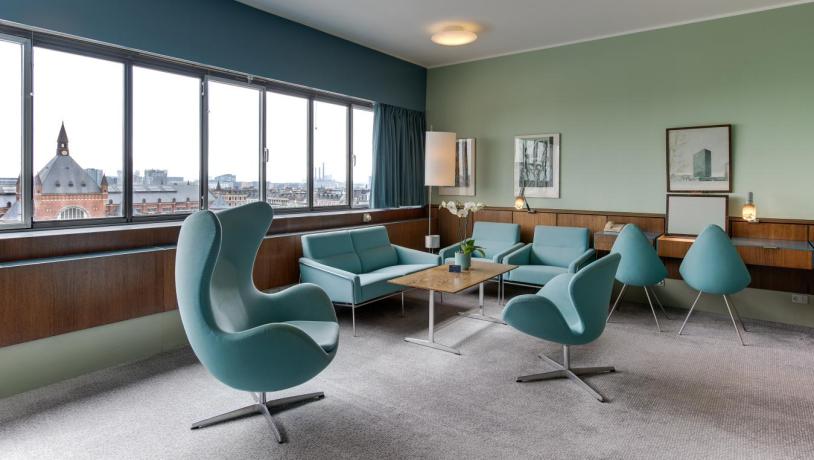How Copenhagen became an architecture and design paragon
Creativity, craftsmanship and democracy are all elements that for decades have helped position Denmark as a frontrunner in innovative design and architecture that improve lives.
Originally, Danish design was a product of the 1950s. The post-war period experienced a lack of materials, and therefore durability and high quality was in demand. Design in this period was thus characterised by simple design, functionality and minimalism.
Danish design is simply made for living. In fact, Copenhagen was the craddle for the concept "design to improve life" - the over-arching theme of the world's biggest design award, INDEX: Award organised by The Index Project.
Some of the most prominent Danish designers from the mid-century period, Georg Jensen, Hans J. Wegner, Finn Juhl and Arne Jacobsen, just to name a few, all made Danish design popular on the international scale.
Today’s designers, such as Louise Campbell, HAY, Normann Copenhagen, Cecilie Manz and Muuto, all draw on elements of the Danish design classics of the post-war era.

L'ensemble du Radisson Hotel a été conçu par l'un des grands architectes danois : Arne Jacobsen, qui a tout façonné : du bâtiment lui-même, à l'intérieur, en passant par la coutellerie et le mobilier, dont beaucoup sont depuis considérés comme des icônes du design danois.Photo:PR photo
Denmark has gradually risen to a high level of fashion consciousness too with shops and fashion designers such as Mads Nørgaard, Henrik Vibskov, Stine Goya and Wood Wood to match. Ever heard of the term democratic fashion? It covers wearable and high quality clothes, which are affordable to most. Not many places can boast of having so many mid-priced shops with quality fashion as Copenhagen.
A history of functionalism
When it comes to Danish architecture, the 1930s introduced rational architecture of concrete, glass and iron, designed to meet the social needs of the time. It later evolved and blended with characteristics from modernism such as using irregular ground plans, open plan interiors, flat roofs and glass facades.
La plage de Bellevue et ses environs abritent une gamme de classiques architecturaux emblématiques de l'un des plus grands architecte et designer danois : Arne Jacobsen.Photo:Martin Heiberg
As if designing furniture was not enough, many of the great Danish designers of the 1950s were also great architects.
Arne Jacobsen became the leading architect in Denmark in the post-war era with the Bellavista houses north of Copenhagen, the town hall of the Copenhagen suburb Rødovre and the Radisson Blu Royal Hotel in Copenhagen, which he designed outside and inside, down to the silverware used in the restaurant, making it the very first design hotel in the world.
In the 1960s, Danish architects entered the world scene following Arne Jacobsen’s example. Most notably is Jørn Utzon’s iconic Opera House in Sydney, now a World Heritage Site, Henning Larsen’s Foreign Ministry building in Riyadh.
Light, water, open spaces and sustainability
Today the cityscape in the centre of Copenhagen is dominated by four to six-storey buildings rather than the typical glass and steel skyscrapers found in many other capital cities. However, the city is far from an architectural standstill. Contemporary architectural additions to the city are shooting up everywhere and manage to blend in beautifully with the old historic buildings and palaces.
Kalvebod Fælled est une vaste zone naturelle dans le quartier Amager de Copenhague. En bordure du paysage urbain urbain, se trouve le bâtiment 8TALLET.Photo:-
Light, water, open spaces and sustainability are the key elements in the recent architectural boom in the Danish capital. The emergence of bold urban planning and world-class architecture is found in four key parts of the city, namely Ørestad, Nordhavn, city centre and not least along Copenhagen’s waterfront. The proximity to and reflection of the water in these new buildings are a common characteristic.
Designed for life
The new constructions are designed for cultural, residential and business purposes, but most importantly for life – and for people. On top of the look and feel of the buildings, the functionality and interaction between people have been top of the architects’ minds.
Le pont cyclable surélevé appelé "Le Cycle Serpent" - Cykelslangen en danois - vous emmène autour du port de Vesterbro à Islands Brygge.Photo:Astrid Maria Rasmussen
Besides the Bicycle Snake, some good examples of this approach are Tietgenkollegiet and 8-Tallet – both residential buildings that are constructed to bring people together. A superb example of an extraordinary bicycle parking space designed for life is seen at Karen Blixens Plads. One of the superstars of Danish architecture in the 21stcentury is Bjarke Ingels, whose architectural footprints are all over Copenhagen. BIG (Bjarke Ingels Group) has designed 8-Tallet, VM Houses, VM Mountain and Superkilen urban park in Copenhagen, to name a few.
Le parc Superkilen est une zone de loisirs populaire dans le quartier Nørrebro de Copenhague. Conçu par les architectes de Bjarke Ingels Group (BIG) en collaboration avec les artistes Superflex, le parc se compose du Red Square, du Green Park et du Black Market.Photo:Martin Heiberg










